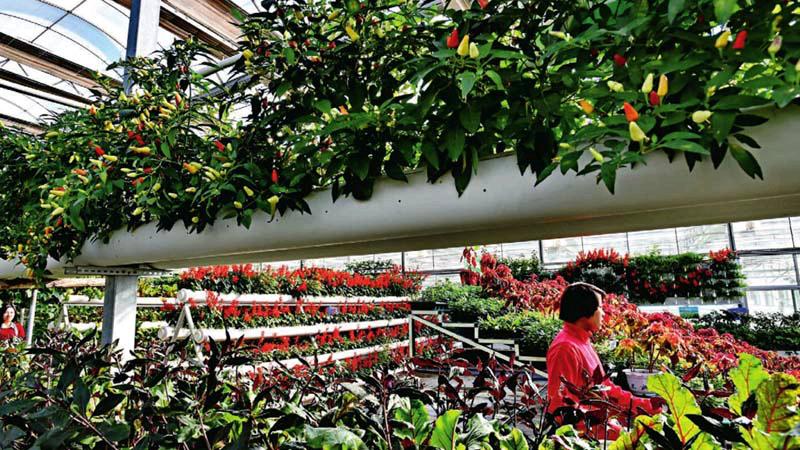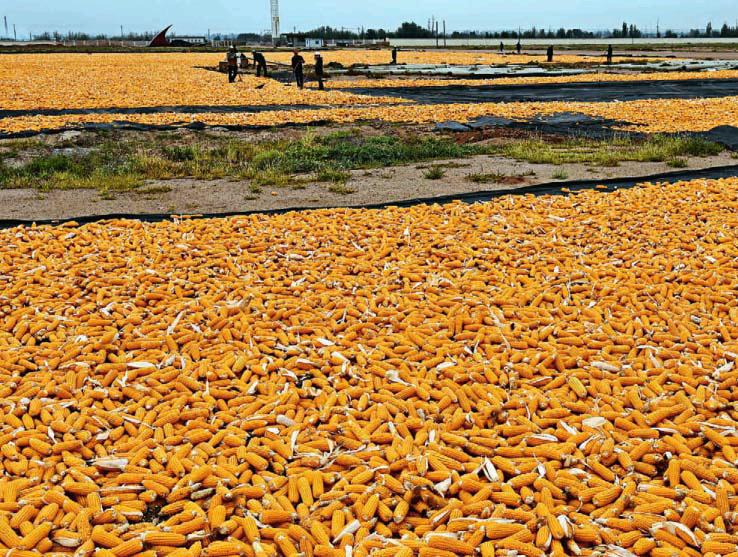The Road to Modern Agriculture
2016-01-19BystaffreportersYAOBEI&MICHAELZáRATE
By+staff+reporters+YAO+BEI+&+MICHAEL+ZáRATE
W ITH its fabled, stunning Danxia landform, Zhangye City in Gansu Province possesses a unique beauty. Walking among colorful rock formations, one might be forgiven for imagining oneself in a dream-wonderland. Admiring such rainbowhued scenery induces a belief that life is so much more than just black and white. Just like the polychrome landscape of this city, Zhangye is heading in diverse directions towards comprehensive progress.
Zhangye is the site famous Chinese film director Zhang Yimou chose to start shoot his movie A Simple Noodle Story. Thanks to abundant water resources(the Heihe River flows by the city), many hours of sunshine and fertile land, Zhangye has become an important agricultural base for the cultivation of grains, fruits and vegetables, as well as the largest hybrid seed-corn production area in China, with its area of arable land reaching 253,000 hectares. Its superior geographical situation ensures high-quality agricultural products. Around 55 percent of Zhangyes agricultural produce is further processed, resulting in high agricultural industrialization levels. Today, Zhangye is actively promoting modern agriculture compatible with environmental protection. In this regard, changes are underway in this vast landscape of China.
Circular Agriculture
Upon leaving the urban area, we saw farmland under cultivation that featured wheat and apples, and an expanse of greenhouses where vegetables such as cucumbers, peppers, cabbages and tomatoes are grown. Gazing into the distance, we saw the towering Qilian Mountains, the snowmelt from which, together with the Heihe River, nourishes the land of Zhangye, and attests to the source of Zhangyes wealth of water resources, incongruous in that it sits amid a desert region.
In 2009, Zhangyes local government cooperated with the Chinese Academy of Agricultural Sciences to establish the Zhangye National Oasis Modern Agricultural Experimental Demonstration Area. In August 2010, Chinas Ministry of Agriculture designated Ganzhou, a district under the jurisdiction of Zhangye City, as among the first batch of national modern agricultural demonstration zones. It became one of the 21 national pilot demonstration areas for agricultural reform in May 2013. Zhangyes exploration into modern agricultural construction set an example for other regions around the country. Zhangyes selection as a demonstration area rests upon three factors: great temperature variation between day and night, many hours of sunlight, and its location at the 38th Parallel north, the same as Murcia in Spain and Sicily in Italy, both highly advantageous locations for crop-growing.endprint
Upon entering Zhangye National Oasis Modern Agricultural Experiment Demonstration Area, we were amazed at its expansive extent. It encompasses about about 2,000 hectares, and includes 12 villages of three towns in Ganzhou District. By the end of 2014, it had received a total investment of RMB 2.4 billion, mostly funded by the local government, but also supported by individual investors. Since 2015, investment in R&D has increased to enhance the experiment to develop agricultural technology. Myriad new strains of flowers, grains and corn have been developed, rendering the demonstration area an important base for seed production in China.
“We plan to build circular agriculture in Zhangye to achieve highly efficient use of resources and increase farmersincomes throughout the entire chain of agricultural production, thus making agriculture an industry that can really boost eco-development of the city,” said Huang Zeyuan, mayor of Zhangye. So, what does circular agriculture mean? Huang explained that it refers to a twoway entirely circular chain linking crop production, the livestock breeding industry and fungiculture (production of edible mushrooms and other fungi). Hay generated from crop production can be used as feed for the livestock industry, while dung generated from livestock production can be processed into compost for fungiculture, and the compost can also be further processed into or- ganic fertilizer for crop production. Of course, after shredding, straw can also be processed into high quality compost for mushroom growing, while animal dung can also be used as organic fertilizer for crop production. In addition, through fermentation, compost made from straw and cottonseed hulls can be converted into organic feed for use in the livestock industry, while compost derived from animal dung can be processed into organic fertilizer for use in crop production.
Thus far, Zhangye has seen the establishment of a 100,000-ton organic fertilizer production line to process animal
dung generated from livestock farming, while another 300,000-ton organic fertilizer production line is under construction. There is another 400,000-ton production line that is able to process waste from crop production – such as straw – into organic fertilizer. “Now we generate 3.5 million tons of straw, and we raise one million head of beef cattle, five million mutton sheep and 1.7 million pigs. It is said that carbon dioxide generated from raising a steer is equal to a cars emissions over a whole year. However, our circular agriculture model can significantly offset carbon dioxide emissions, as well as reducing the use of chemical fertilizers,” said Huang. “We develop local agriculture with a focus on industrialization, thus well protecting our environment even as we deal with agricultural waste,” Huang added.endprint

Since its establishment in 2009, the demonstration area has tried all efforts to better conserve water. Therefore, they decided to adopt a drip irrigation system that is mainly used in arid areas. This system was initially imported from Israel, but Zhangye later developed its own technology independently. Now all the facilities are made in China and the local government has started to promote this irrigation system among local farmers.
During our visit we saw an experimental field that covers around eight hectares devoted exclusively to the planting of five strains of corn, three types of wheat, and 26 varieties of flowers. In addition to supplying the domestic market, the seeds of those new varieties are mainly exported to Russia.
Characteristic Agricultural Products
Zhangyes geographic location also makes the city ideal for winemaking, an industry that has grown dramatically in China in the past 15 years. In April 2015, the International Organization of Vine and Wine (OIV) announced that China had become the second largest vineyard area in the world, with nearly 800,000 hectares of land devoted to viticulture. China accounted for 11 percent of the worlds territory given over to vineyards last year, up from 4 percent in 2000.
One of the wineries here is the Gansu Qilian Winery Co., Ltd, which produces and markets the brand Qilian Chuanqi(“The Legend of Qilian”). Its vineyard lies in Gaotai County, and spreads over 10,600 hectares. We picked and tasted grapes during a tour of the vineyard, a pleasure that equaled savoring a glass of wine in this picturesque mountainous area.
Our arrival coincided with the grape harvest season, which occurs twice a year: first between September 22 and October 22, and second between late October and late November. The grapes harvested at the latter time are perfect for making ice wine as Gaotai is quite cold during that period. The ice wine is a featured product that Gansu Qilian Winery is trying to promote in the domestic market. Although it may be a little too sweet for most Westerners, it is more palatable to customers in China and other parts of Asia.
“Currently our wine is exported to Japan, Malaysia and Southeast Asian countries. This vineyard was founded in 1998. At that time the Chinese people had just started to drink wine. We did not have a lot of technology in the very beginning. Our winemaking technology has improved with the passage of time. However, domestic consumers have also gained greater knowledge of wine, and we therefore need to offer products of higher quality to our more sophisticated customers,” said Qi Luping, manager of the vineyard.endprint
Wine production is also a link in modern circular agriculture. Zhangyes local government wants to link wine production with tourism development. For example, tourists can also visit the vineyards, wineries and wine cellars.
By exploring a circular agriculture model and developing tourism through growing new and specialty agricultural products, Zhangye expects to establish a new modern agricultural development model which is both sustainable and environmentally-friendly. When we asked Huang Zeyuan how the city will be 10 years from now in his imagination, he said, Zhangye will be first and foremost an ecological city, with its eco-environment constantly improving and contributing to remediating the ecology of the entire country. Also, he anticipates that Zhangye will grow into an international tourist destination as a famous historical and cultural city. “My management seeks the harmonious development of agriculture, ecology and culture,” Huang said.
Only time will tell if Zhangye will reap these rewards and so embrace a better future.endprint
